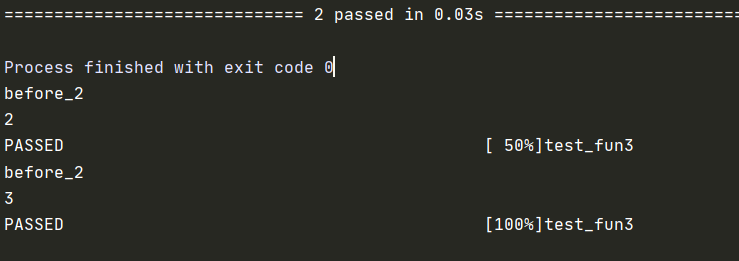pytest-fixture 的使用
unittest 有自己的setup 和teardown 功能,起到前置处理和后续清理的作用 ,pytest 有自己的方法单独做这些工作 -----这就引入了fixture
- 给函数打个标记 ,实现前置处理和后续清理的作用 @pytest.fixture
- 如何使用这个函数呢 有三种方式
2.1函数名称作为参数传入
2.2 使用usefixture (fixture 名称)
1 import pytest 2 @pytest.fixture() 3 def before(): 4 print('这是before') 5 6 #第一种方法:把函数名称直接作为参数传入 7 def test_fun(before): 8 print('test_fun')
1 @pytest.mark.usefixtures('before')
2 def test_fun1():
3 print('test_fun1')
运行结果


注意:但是有的时候fixture 是需要有返回值的,那么就只能用传参的方式,这样才能接收返回值
1 @pytest.fixture() 2 def before_3(): 3 a=1 4 b=2 5 yield a,b 6 c=3 7 print('这是后置处理工作') 8 9 def test_fun3(before_3): 10 print(before_3) 11 print(before_3[0]) 12 print('这里省略函数内部处理')
运行结果

2.3 使用auto=True 这种方法会对所有的test 函数起作用
1 @pytest.fixture(autouse=True) 2 def before_auto(): 3 print('before_auto') 4 5 def test_fun2(): 6 print('test_fun2')
运行结果

3.fixture 参数化 使用params 传入参数,在函数内部用request.param 接收参数
1 @pytest.fixture(params=[2,3]) 2 def before_2(request): 3 print('before_2') 4 print(request.param) 5 6 7 #@pytest.mark.usefixtures('before_2') 8 def test_fun3(before_2): 9 print('test_fun3')
运行结果

posted on 2021-04-20 17:29 kimber_kimber 阅读(66) 评论(0) 编辑 收藏 举报


